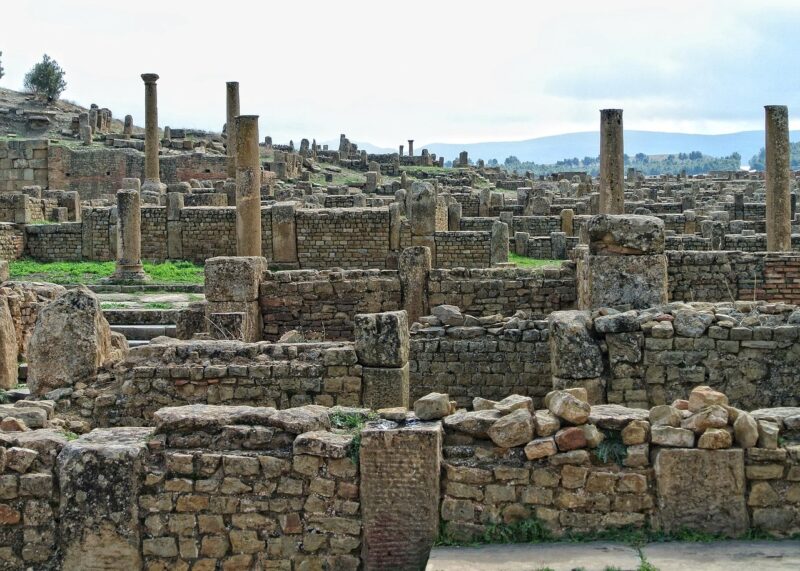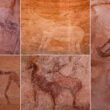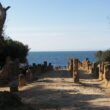In the arid high plains of northeastern Algeria lies one of the most impressive Roman archaeological sites in the world — Timgad. Often referred to as the “Pompeii of Africa,” Timgad is a stunning example of Roman urban planning and architecture, preserved beneath layers of Saharan dust for centuries.
Built by the Roman Emperor Trajan in 100 AD, this once-bustling city now stands in silent grandeur, inviting travelers, historians, and photographers to step back in time. With its straight streets, grand public buildings, and majestic archways, Timgad offers a rare glimpse into daily life in a Roman provincial city.
Where is Timgad Located?
Timgad is located in northeastern Algeria, in the Batna Province, approximately 35 km east of the modern city of Batna and 480 km from Algiers. Nestled at the foot of the Aurès Mountains, the city is easily accessible by road and is a popular stop on historical and cultural tours of Algeria.
Why is Timgad So Special?
1. Immaculate Roman City Planning
Timgad is one of the best surviving examples of Roman grid layout, with its streets laid out in a perfect orthogonal plan. The two main streets — the cardo maximus (north-south) and decumanus maximus (east-west) — intersect at the heart of the city, creating a symmetrical pattern that modern urban planners still admire.
2. Spectacular Ruins
Despite centuries of desert encroachment, Timgad’s ruins are remarkably intact. Highlights include:
- The Trajan Arch: A monumental gateway standing 12 meters high.
- The Capitol: A temple dedicated to Jupiter, Juno, and Minerva.
- The Forum: The civic center once bustling with trade and political life.
- A library, basilicas, baths, and a theatre that could seat 3,500 spectators.
3. A UNESCO World Heritage Site
Recognizing its historical and cultural value, UNESCO declared Timgad a World Heritage Site in 1982. The site showcases not just Roman brilliance but also the strategic and cultural importance of North Africa in the Roman Empire.
Top Things to See in Timgad
1. The Trajan Arch
This iconic triumphal arch is Timgad’s most photographed landmark. Its impressive structure, with Corinthian columns and intricate carvings, marks the eastern gate of the city.
2. The Roman Theatre
Still used for events today, the semi-circular theatre exemplifies Roman acoustics and design. Climb to the top rows for panoramic views of the ruins and surrounding landscapes.
3. The Forum
The heart of Timgad, this rectangular public square was once lined with shops, temples, and administrative buildings.
4. The Library
One of the few known Roman libraries, it held over 3,000 scrolls. Its layout with reading rooms and lecture halls provides insight into Roman education.
5. The Baths
Typical of Roman leisure culture, the public baths included cold (frigidarium), warm (tepidarium), and hot (caldarium) sections — a marvel of ancient engineering.
How to Visit Timgad
Getting There
- By Air: The nearest airport is in Batna, which connects to Algiers and other major Algerian cities.
- By Road: Timgad is accessible by car or tour bus from Batna (approx. 45 minutes).
Best Time to Visit
Visit between October and April to avoid the scorching summer heat. The spring months are especially pleasant, with wildflowers blooming among the ruins.
Tips for Travelers
- Hire a local guide for historical context and navigation.
- Wear sun protection — the site is exposed with minimal shade.
- Bring water and snacks, though a small café and shop may be nearby.
- Respect the site — don’t climb on the ruins or remove artifacts.
- Photography is encouraged — especially at sunrise or sunset when shadows cast beautifully on the stonework.
Timgad in Historical Context
Timgad was originally a military colony for Roman veterans of the Third Legion. Its layout and infrastructure reflected both strategic necessity and Roman ideals of civilization. As the city flourished, it became a center of culture, trade, and governance in Roman North Africa.
The city began to decline by the 5th century due to Berber invasions and later Byzantine rule. Eventually, it was abandoned and swallowed by the Sahara until rediscovered and excavated by French archaeologists in the 19th century.
Modern-Day Timgad
Today, Timgad is one of Algeria’s most important tourist attractions. The site hosts cultural festivals, such as the Timgad International Music Festival, and draws visitors from across the globe interested in Roman history, archaeology, and North African heritage.
10 Frequently Asked Questions (FAQs)
1. Is Timgad worth visiting?
Absolutely! If you’re interested in Roman history or archaeology, Timgad is one of the most remarkable and accessible ancient cities in Africa.
2. How old is Timgad?
Timgad was founded in 100 AD, making it over 1,900 years old.
3. Who founded Timgad?
Roman Emperor Trajan founded the city as a colony for retired soldiers.
4. Is there an entrance fee?
Yes, there’s a modest fee (around 200-300 DZD) for entry. Prices may vary for foreign visitors.
5. How long should I spend at the site?
A thorough visit takes 2 to 4 hours, depending on your interest level and whether you’re on a guided tour.
6. Are there guided tours available?
Yes, local guides are available at the entrance or can be booked through Algerian travel agencies.
7. Can I take photos at Timgad?
Yes, photography is allowed and highly recommended. Drones may require special permits.
8. Is the site accessible for people with disabilities?
The terrain is uneven and mostly unpaved, which may make access difficult for some visitors.
9. Are there nearby attractions?
Yes, the Aurès Mountains, the city of Batna, and Lambaesis (another Roman site) are nearby.
10. What language do guides speak?
Most guides speak Arabic and French; some also offer English tours upon request.
Read about all the World Heritage Sites
Conclusion: Timgad — A Roman Gem in Algeria’s Heartland
Timgad is more than a collection of ruins; it’s a living museum of Roman brilliance and an emblem of Algeria’s deep historical roots. With its pristine city plan, architectural marvels, and dramatic desert backdrop, Timgad offers a travel experience that is educational, awe-inspiring, and off the beaten path.
Whether you’re a history lover, photographer, or curious explorer, Timgad will leave you marveling at the legacy of ancient civilizations — a timeless echo of Rome in the heart of Africa.









